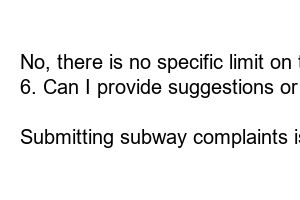지하철 민원 넣는 법
Title: Subway Woes? Here’s How to Effortlessly Submit Complaints and Improve Your Commute Experience!
Introduction:
Commutes can often be stressful, especially when subway services fail to meet our expectations. Thankfully, there’s a straightforward solution to voice your concerns and facilitate improvements—the submission of subway complaints. In this blog post, we’ll guide you through the process step-by-step, ensuring a hassle-free experience with practical tips, guidelines, and important dos and don’ts.
1. Why Submitting Subway Complaints Matters:
Submitting subway complaints serves as a valuable feedback mechanism, allowing authorities to understand passenger experiences and identify areas that require immediate attention. By voicing your concerns, you become an active participant in shaping a better and more reliable subway system.
2. How to Submit a Complaint:
To submit a complaint, start by locating the official website of your local subway system. Look for the “Contact Us” or “Customer Support” section and explore the options provided. Find the dedicated complaint submission channel, which may include an online form, email address, or helpline number. Choose the method that suits you best and follow the instructions provided to document your complaint effectively.
3. Essential Information to Include in Your Complaint:
When drafting your complaint, it’s important to provide specific details to help the authorities address your concern promptly. Include information such as the date, time, and location of incident, along with train and carriage numbers, if applicable. Clearly articulate the issue you faced, highlighting how it impacted your commute. A comprehensive and concise complaint tends to have a higher chance of getting resolved effectively.
4. Tips for Effective Complaint Writing:
To effectively convey your concerns, adopt a respectful and polite tone while describing the incident. Stick to factual information rather than relying on emotions, ensuring the authorities understand the situation clearly. While it’s tempting to exaggerate or vent frustrations, polite and concise language is more likely to facilitate a constructive response.
5. Following Up on Your Complaint:
After submitting your complaint, it’s essential to follow up to ensure action is taken. Keep a record of any complaint reference number provided and diarize a follow-up date. If you haven’t received a response within a reasonable timeframe, politely reach out again to check on the progress and show your dedication towards resolving the matter.
6 FAQs
1. How long does it take for subway authorities to respond to complaints?
Subway authorities strive to respond within a specific time frame, typically within 2-4 weeks. However, the response time may depend on the complexity and urgency of the complaint.
2. Can I submit a complaint anonymously?
While some subway systems allow anonymous complaints, providing your contact information improves the chances of resolving the issue promptly. Rest assured, your personal details will remain confidential.
3. What happens after I submit a complaint?
Upon receipt of your complaint, subway authorities will investigate the matter, gather relevant information, and take appropriate action based on their findings. You may receive a response acknowledging your complaint or providing updates on the progress made.
4. Can I receive compensation for my inconvenience?
In certain cases, subway authorities may offer compensation for significant inconvenience caused. However, this will be assessed on a case-by-case basis, depending on the policies and regulations of your local subway system.
5. Is there any limit on the number of complaints I can submit?
No, there is no specific limit on the number of complaints you can submit. Feel free to voice your concerns whenever necessary, as subway authorities rely on passenger feedback to improve their services continually.
6. Can I provide suggestions or feedback alongside my complaint?
Absolutely! In fact, subway authorities encourage passengers to provide suggestions or feedback along with their complaints. Your ideas could contribute to the overall improvement and innovation of the subway system.
Summary:
Submitting subway complaints is a powerful tool that allows you, as a passenger, to contribute to the improvement of your daily commute experience. By following the outlined steps, providing essential details, employing effective complaint writing skills, and diligently following up, you increase the likelihood of having your complaint resolved satisfactorily. Remember, your feedback matters, and with your active participation, the subway system can evolve into a more efficient and reliable mode of transportation.

